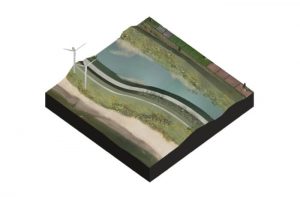Get Started
A predominantly salt/brakish zone along the coast in between dikes/levees is zone as a coastal buffer zone, or “inlaag” in Dutch. Historically these areas arose when people built a spare inner dike parallel to the coastal defence when there was a threat of dike failure. Because of the presence of a secondary dike, the primary coastal defence can suffice with lower safety standards as for example reduced height. Limited overflow during extreme high water conditions is acceptable because the secondary dike will stop the water from inundating the land behind the secondary dike. This is interesting from a cost and dike maintenance point of view especially with respect to sea level rise. The area between the dike is not suitable for high quality land use as housing, but can serve as nature and recreation area and also has potential for aquaculture.

Inlagen of the Oosterschelde
Historically an “inlaag” was used in the Netherlands as buffer zone between the sea and the inhabited area behind the dikes. If an area seemed no longer safe to inhabit because of a progressing sea a secondary inner dike was built. This dike was meant to provide protection in the unfortunate case the primary dike would fail. Nowadays “inlagen” are still preserved or reconstructed along the coast of Schouwen-Duivenland and Noord-Beveland in the Southwest Delta in the Netherlands. The area between the dikes is usually unattractive for agriculture due to high salinity concentrations in the soil (seepage). Due to the historic character an “inlaag” also holds high cultural values.
Related pages
Comparable applications are described in the Building Solutions Managing coastal retreat and Developing inland buffer zones.
Required skills
With this Building Solution description, anyone with a basic level of knowledge and/or working experience on coastal systems can make a first order assessment.
BwN interest
The added value of this Building Solution within BwN-type projects is that it enables the creation of coastal protection systems in a multi-functional way, combining nature, recreation and aquaculture. This Building Solution is mainly applicable in the planning and design phase.

